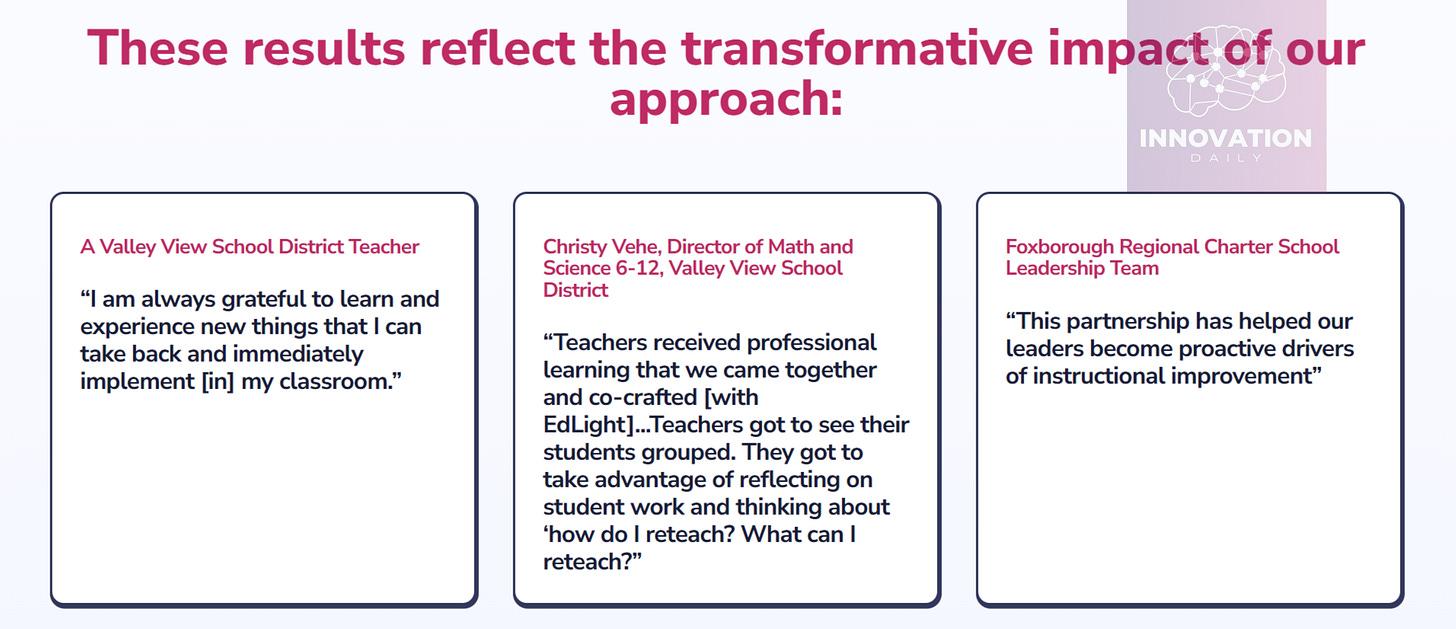Hey, Teacher, Leave Them Kids Alone
Today's featured startup is trying to make AI work for the teachers — instead of against them.
Project Overview
EdLight is a platform that helps teachers give meaningful feedback to students on the work they submit. But this isn’t just about grading — it’s about nurturing how students think. The startup’s mission is to make teacher feedback a tool for cognitive development, not just evaluation.
Here’s the twist: students submit their work as digital images. No need for fancy software — a simple drawing on paper, held up to a webcam or phone camera, will do. Whether it’s a graph with handwritten notes, a table of conclusions, or a formula with commentary, EdLight values how students reach their answers — not just what those answers are.
Teachers then respond to the very same image by adding comments, drawings, and even voice notes using the platform’s built-in editor. The goal is to coach the thinking process, not just to assess the final result.
All submissions and feedback are saved in a digital portfolio, visually documenting a student’s learning journey. This allows both teachers and students to identify patterns, reflect on progress, and see exactly how thinking evolves over time.
These portfolios can also be shared with parents, tutors, or other educators — turning a student’s learning into a collaborative process centered on insight, not just scores.
The platform offers a free tier for individual teachers, with a standard plan priced at $15/month or $144/year. School-wide and district-wide licenses are also available.
As of now, EdLight is used in 20 U.S. schools, along with a number of individual educators. In 2023, the startup tripled its revenue to $655,000. Previously funded by grants — including $150,000 from Google for Startups and over $3 million from the Gates Foundation — EdLight recently closed a $4 million investment round.
What’s the Gist?
There’s been a surge in startups focused on improving the feedback teachers give to students — and it’s no coincidence.
First, feedback has always been a cornerstone of quality education. Second, we now have AI tools that can make this process dramatically more efficient.
Some examples:
Graide helps teachers automatically generate feedback for student work based on similar responses they’ve evaluated in the past. It’s especially helpful for recurring mistakes. The startup raised £2.5M.
Sizzle offers step-by-step hints for homework, guiding students to discover solutions on their own. It raised $7.5M.
Packback gives students suggestions for improving their writing — and helps teachers assess it using the same algorithms. It even moderates classroom chats and provides real-time AI-generated feedback. Total funding: $12.2M.
EdLight has been called an “AI platform” in some write-ups, though there’s no clear mention of AI on their site — yet. Given the trend and their visual-first approach, it’s easy to imagine their own AI assistant soon analyzing handwritten responses and offering visual or voice-based feedback.
This “visual thinking” approach is particularly compelling. Think about how adults often sketch ideas on napkins — little diagrams, boxes, arrows, scribbles — to clarify our thoughts or explain things. EdLight brings that same logic into education: learning as a visual process. And perhaps even more importantly — learning how to think through that visual process.
They’re not alone. Startups like:
Piggy ($7.7M raised) built a mobile platform for creating visual “stories” — like vertical-format slides combining text, images, and video — as a new form of expression, even for serious use cases like business reports.
Antimatter ($2M raised) lets students create memes on academic topics, based on the idea that if you can joke about something, you probably understand it.
All these tools reflect a shift: students want to express ideas in the same way they consume them — visually, interactively, and creatively.
Key Takeaways
The goal of education is not to memorize, but to think.
That means feedback should focus not just on right or wrong answers — but on how students got there, and how they can get there.AI is ready to scale feedback in a smart way.
It can reduce the burden on teachers and help every student get meaningful input, faster and more often.Modern formats belong in the classroom.
Visuals, stories, videos, and memes aren’t distractions — they’re tools. Students already think this way. It’s time education caught up.
There’s real momentum — and massive opportunity — in rethinking how we teach students to think. EdLight and others are just scratching the surface. Somewhere at the intersection of visual learning, AI, and feedback lies the next billion-dollar idea.
Where would you start digging?
Company info:
EdLight
Website: edlight.com
Latest round: $4M March 27, 2024
Total funding: $7.25M across 3 rounds













